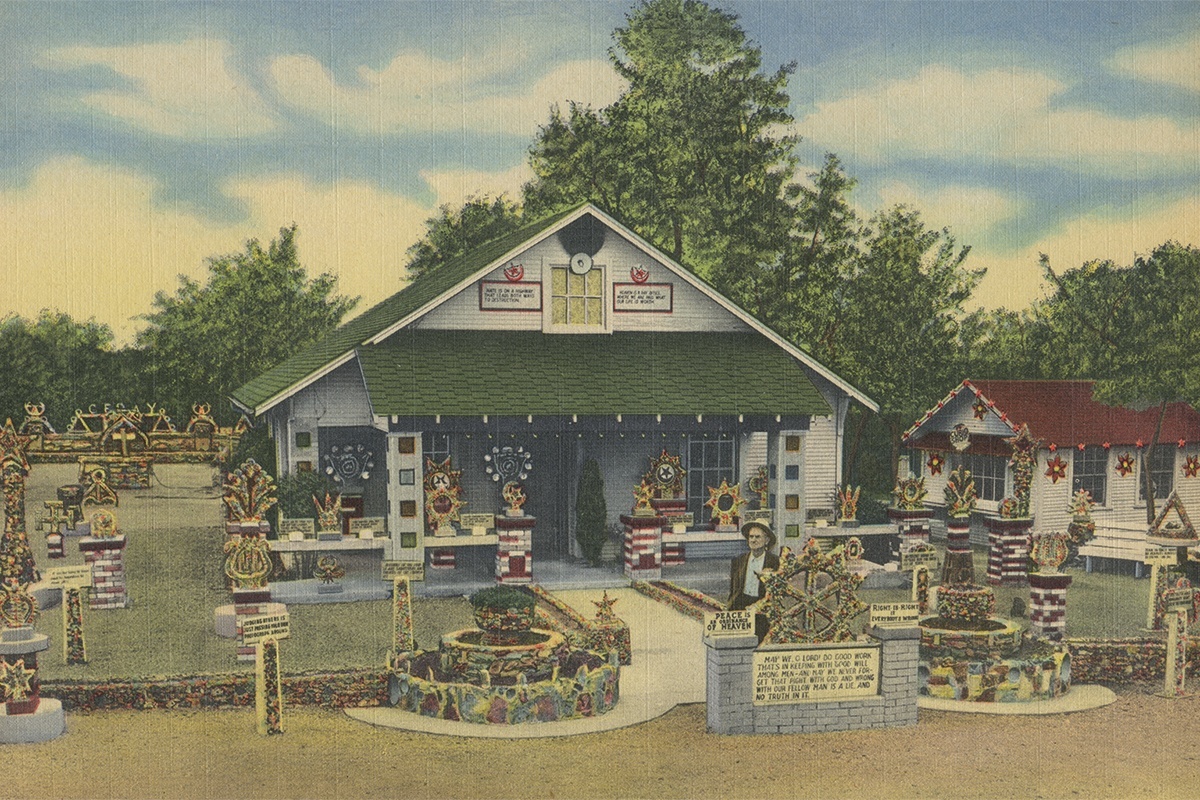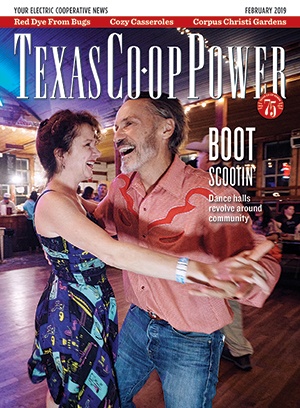In the early 1950s, a young couple strolled through the wonderland of Ray’s Ornamental Gardens, a roadside folk art experience in Stephenville, according to a story in a 1957 issue of The J-TAC, the student newspaper at Tarleton State College. “That man must be crazy to do such a thing as this,” remarked the young lady as she surveyed concrete sculptures decorated with radio tubes, colored glass, tile, shell and petrified wood. From speakers that wafted gospel music through the gardens, they heard, “Well what difference does it make? A man’s got to be crazy about something.”
The disembodied voice belonged to George Ellis Ray, a folk artist and philosopher who created the elaborate sculpture garden of stars, hearts, lyres and “designs never before thought of,” according to a 1961 issue of The J-TAC. The article described a “mecca for lovers of the unusual and the bizarre.” Ray operated a grocery, café and feed store in Stephenville, but his life’s work was this expansive display of yard art that included signs proclaiming his homespun proverbs.
“What a man does comes from what he’s thinking about,” read one. “Prejudice parks in an empty heart,” another read. “No man is above what he says about others.” And “The further out on the sea of thought we go, the more we see that we don’t know.”
“Oh, yes, it was very popular,” says Wayne Sherrod, a member of the Stephenville Historical House Museum board of directors. “People would go to Minnesota to see the giant ball of twine, to Illinois to see the giant rocking chair and then to Stephenville to see Ray’s Ornamental Gardens.”
According to his obituary, Ray, a native of Tennessee, came to the Cross Timbers country of Erath County in 1912 with his first wife, Melissa, who died in 1935. He bought property on a hill above the Bosque River in 1939. Pillars in the open-air gallery spelled “R-U-T-H” in tribute to his second wife.
The rarefied tastes of the art world cognoscenti found the site intriguing. Dallas artist Martin Delabano says that his father, Barney Charles Delabano, also an artist, first saw it when he was working at the Dallas Museum of Art. Delabano believes the museum’s former director, celebrated regional painter Jerry Bywaters, also visited the site.
Stephenville folks found Ray’s Ornamental Gardens just as intriguing. “My father would take us out there at night, when it glowed with all the lights,” recalls Sherrod. From the age of 5 until 10, resident Sheri Smith visited often with her Girl Scout troop. “Our scout leader, Mrs. Willis, would take us,” Smith says. “She was a fortuneteller. I barely remember seeing Mr. Ray working on the ornate displays. It reminded me a little bit of a sculptor working on Mount Rushmore.”
Joyce Whitis moved to Stephenville from Dallas with her husband in 1952 to escape the big-city traffic and buy a farm. “One of the first things I heard about when I got here was Ray’s,” she says. “I still have the decorative plaster of Paris items I bought at the gardens’ shop.” Longtime Tarleton librarian Glenda Stone did Christmas shopping at Ray’s. The late Bill Stem, a longtime Stephenville banker, popped the question to his sweetie, Jo, at the gardens’ fountain.
Very little of Ray’s Gardens remains today, and even those fragments are in ruins after decades of disrepair.
Martin Delabano visited the Ornamental Gardens as a child as part of a family road trip in the early 1960s. “It was sort of in decline then,” he says. “My wife, who is from Stephenville, took me back early in our courting. It was pretty much gone except for the remains of the foundation of the garden. A big orb sat in the middle, made up of huge chunks of glass. I think it had been wired. It must have looked like a glowing comet that landed in the middle of the garden at night. My wife said it was a favorite place for Tarleton rodeo cowboys to practice their roping.”
Writer Gene Fowler specializes in Texas travel and history.


